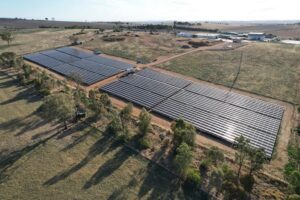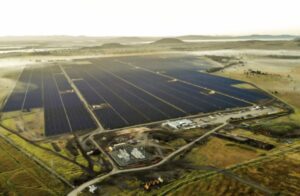Two years ago, Queensland cotton farmer Ian Brimblecombe installed a 30kW tracking solar system near his irrigation pump site in, in the heart of Barnaby Joyce country. The solar panels worked so well that he decided he wanted to add an extra 30kW, to offset the costs of his considerable energy needs.
But then he got a shock. Under the new tariffs put together by the state-owned utility, Ergon Energy, Brimblecombe was facing a massive increase in energy costs – even if he did put more solar up to generate his own electrons. The tariffs of 29c/kWh at peak and 10c/kWh at night had been replaced with a new 10.6c/kWh flat tariff, accompanied by increased fixed charges – meaning that the economic incentive to put in more solar was all but wiped out.
But it gets worse. Brimblecombe has two pump sites. One, with a 200kW electric motor (plus the 30kW solar), used 97,000kWh last year. At the second site he has a 70kW motor and used about 86,000kWh last year. He planned to put another 30kW of solar at this site and was in the process of increasing this to a 220kW electric motor.
But if his usage goes over 100,000kWh, he becomes a “large user” and loses the solar tariff of 44c/kWh. That would nearly quadruple his bill from $20,000 to $74,000. “So next year I will probably replace the electric motor with a diesel motor, unless I can get a decent tariff that reflects time-of-use pricing,” he tells RenewEconomy.
It seems to be part of an increasing pattern of behaviour from energy utilities, and Brimblecombe is not impressed. “Unless we can fight these tariffs my only option is to go to a diesel engine on my pump,” he says. “We really need some smart economist to come up with some better tariffs that rely less on demand charges and charge more for usage at peak times. With these current tariffs, businesses will just go off the grid.”
And it’s not an isolated case. Despite the rhetoric from state governments about rising electricity costs, the state-owned utilities in NSW and Queensland, in particular, are denying their customers the opportunity to invest in their own equipment to reduce their costs – not just by changes to solar tariffs, but by framing general tariffs in such a way that solar could no longer be used as an offset.
Geoff Bragg highlighted the issue in this piece for RenewEconomy a few months ago, when he wrote about the “solar squeeze” being applied by Essential Energy in the same manner to its commercial customers in NSW. And the Australian Photovoltaic Association recently focused on the growing reluctance of utilities to connect commercial-scale solar in a submission to the Australian Renewable Energy Agency.
The APVA says there is evidence that network operators, as well as retailers and generators, are increasing their opposition to distributed generation such as commercial solar, because of reduced sales and the so-called “merit order effect’.
It says restrictions have been placed on new PV installations in some areas, significant tariff reductions have been offered to customers applying for PV connections, and major barriers have been placed on commercial PV installations. And they get away with it because the APVA says commercial installations have no grid connect mandate or guidelines and no policy support.
It cites one instance where a proposal for a 30kW system was quoted a connection cost of $100,000 – with no explanation given or required. In other cases, there were delays of a year or more between submitting applications and getting feedback.
Why would utilities act in such a way? Quite simply, to protect their business models.
The APVA says that the levellised cost of energy for commercial-scale solar is now equal to, or lower than, publicly available retail electricity prices. Unlike residential solar, commercial-scale PV systems better match commercial loads, and could therefore be very useful in peak demand management and to minimise grid exports. And commercial systems were larger, increasing the market and decreasing prices faster through economies of scale.
However, any significant reduction in electricity consumption, especially per customer, will put increasing pressure on the utilities’ traditional revenue and business models, which depend on kWh sales for the bulk of their revenue.
The APVA notes that if Australia installed more than 8GW of rooftop PV by 2020, as it would with only 15 per cent growth per annum in the coming eight years, this would represent around 5 per cent of total electricity demand. But because most would be in the form of distributed generation on the commercial and residential networks, it would radically change demand patterns and network requirements. Some private forecasts put the potential of rooftop PV at up to twice that amount.
“If kWh (kilowatt hour) sales continue to fall, one response to maintain retailer and network operator revenue may be to increase service availability and network access charges,” the APVA noted (as happened to Brimlecombe). “However, customers are unlikely to respond favourably to increasing bills as their electricity use decreases,” it added (as is also the case with Brimblecombe).
The APVA said new regulatory arrangements need to be put into place as soon as possible to cater for this new market to avoid “perverse customer behaviour” and “uncompetitive practises from the incumbent gentailers. “
The APVA aims to develop a standard ‘default’ connection procedure which can be used in all states and territories, and some transparency in the process and for finding out what the issues and costs are at a site. It complains that these processes are protected as “commercial in confidence”, but this effectively blocks new market entrants.
It also wants the utilities to publish their “hot spot” maps so the industry can see where network expenditure is likely to be required over the next five years, and hence where energy efficiency, renewable energy or demand management could be cost-effective to implement.
Brimblecombe would simply like some of the new retail tariffs, which propose peak rates of 38c/kWh and discounted off-peak rates to be extended to commercial customers.








